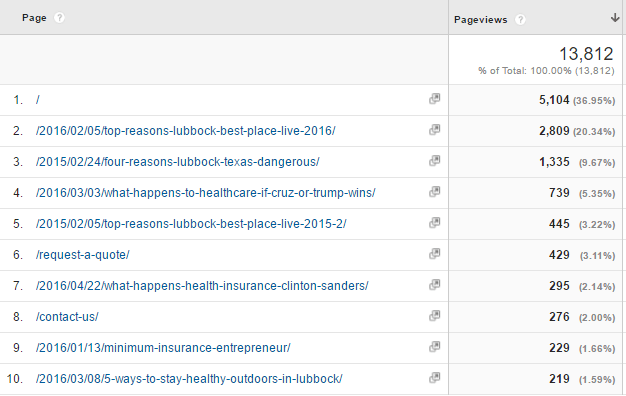Local SEO: Become the voice online for your market
How can you improve online visibility for your local business? Columnist Corey Barnett advises producing content of interest to your community, even if it's not directly related to your business.
When it comes to local content marketing, too many businesses fall into the trap of self-promotion, writing solely or primarily about their products and services. Or worse, their blog is rarely updated, or it’s full of filler content that only serves to boost search rankings. Rarely does this approach translate into engaged visitors or traction on social media.
Instead, it’s worth writing about what your audience cares about: your local community! Where you sell and who you sell to are more important than what you’re selling.
The local long-tail opportunity
Here’s an example. A local insurance agency I work with has long ranked in the first position organically and in the local map pack for most of their services. They sell auto, home, life, health and business insurance. This client also has a positive reputation online, earning rave reviews on Google and Facebook.
However, they weren’t gaining followers on social media, and website visitors were stagnant. Despite ownership of their industry’s most competitive keywords, the market was small. In a city of 250,000, only a handful of residents were actively looking for their services in Google.
So we started to write about what locals cared about. For the past two years, we’ve done a list article on all the reasons their city is the best place to live. In some months, it even outpaces traffic on the home page.

The Top 10 Pages on a Local Insurance Agency Website (Jan to May 2016)
Takeaways
- Four of the top 10 most popular pages have nothing to do with their services.
- 35 percent of traffic is coming from blog posts focused on their community.
- 44 percent of traffic is coming from the blog.
Other articles we’ve written include activities to do outdoors, where to propose in their city and the truth about local crime. The formula is to write blog content aligned with your audience and location, even if it doesn’t directly align with your service. These topics would work for most cities and consumer-facing businesses.
Competition abounds
BuzzFeed, Thrillist and other sites are becoming known for generating the type of content that goes viral on social media and gets read and shared. In recent years, these sites have localized their content.

Results on “Ann Arbor, Michigan” from BuzzFeed.com
Here’s the thing: The writers for these posts often don’t live in the communities they write on. Additionally, they rarely write about small cities and barely scratch the surface with a few generic topics.
Perhaps a local newspaper, local magazine or news site is generating this type of content in your community. Even so, their articles are probably behind a paywall, stuffed with ads and slow to load on mobile.
Real estate is a prime example of an industry applying this formula to scale. Movoto.com is among the top 10 most-visited real estate websites. It was founded in 2005 but has grown in popularity due to an aggressive approach to localized blog content. Articles include “best of” listicles and niche rankings like the most boring cities in America.
Chances are, Movoto is attracting thousands of visitors each month in your local market — on a blog post you could have written.
Write about your community
Apply this approach with your audience and location. Think beyond what you sell — write on challenges, opportunities and changes facing your local community.
It doesn’t always have to be a blog post. For a real estate agent in Ann Arbor, doing an interview with the owner of a craft beer bar is the same formula. Beer has nothing to do with real estate, but it has everything to do with a demographic she wants to reach in her local market.
Here are more examples aligned with common businesses in any city.
- Nursing home: We Interviewed the Oldest Living Residents of [insert county], Here’s What We Learned
- Accountant: 2016 Biggest Employers in [insert city] Ranked by Employees & Revenue
- Restaurant: 5 Ingredients to Forage Near [insert city]
- Auto mechanic: The Perfect Road Trip Through [insert city]
- Boutique shop: The Best-Dressed Fans at [insert local college football team]
Even if loosely aligned with your product/service, these topics are sure to please your community and audience.
Write about timely issues that affect your audience + location
Timeliness is something we’ve all heard is important in content marketing. Amp up the formula by taking an issue that strongly aligns with your audience today!
For example, I’ve taken several controversial topics on politics and spun it for my insurance client with their perspective.
- How Will Open Carry Affect Insurance & Liability for Texas Businesses?
- What Happens to Obamacare if Cruz or Trump Is Elected?
- What Happens to Health Insurance if Clinton or Sanders Is Elected?
I realize now that many of these articles are questions, but that’s just another tactic to generate discussion! A second tactic is partnering with a local business. On the first article, we provided a balanced perspective from a personal injury lawyer and my insurance client. Involving another author doubles the exposure and boosts credibility.
On the last two articles, a slew of comments followed on Facebook. Not all of it was positive. One commenter literally asked what Clinton and Trump have to do with insurance! Truthfully, the winner of the 2016 election will dramatically affect health insurance. Just as if Cruz was elected, abolishing the IRS would affect accountants, and Trump would affect any business that imports or export products.
Tread carefully, but realize you do have the freedom to share your opinion. You can also write neutrally about these topics, sharing an industry perspective, yet hiding personal beliefs.
Promote your content & measure the impact
Over time, articles that follow this formula can rank for many long-tail search terms and boost average time on site. I call this “first impression” content since they become popular landing pages. Such content also targets a prospect at the beginning stage of the buying cycle.
That’s an important stage to write for. It’s similar to building brand visibility through a TV commercial, radio ad or display ad. With this content, you’re able to attract engaged visitors to your blog. You may find these types of posts have high exit rates. You can improve conversion by adding a pop-up lead form and improve time on site by featuring similar articles on your community in the sidebar.
This content is also in a good position to be pitched to local newspapers and magazines, increasing referral traffic and earning backlinks.
Finally, it can easily go viral when promoted on social media. Create a good image and promote the article on Facebook or LinkedIn, depending on your audience.
Layer “first impression” content into your editorial calendar and combine it with timeliness to make it extra relevant. In a few months, you’ll realize content that follows this formula is low-hanging fruit, ripe and ready to be eaten!
Opinions expressed in this article are those of the guest author and not necessarily Search Engine Land. Staff authors are listed here.
Related stories
New on Search Engine Land


